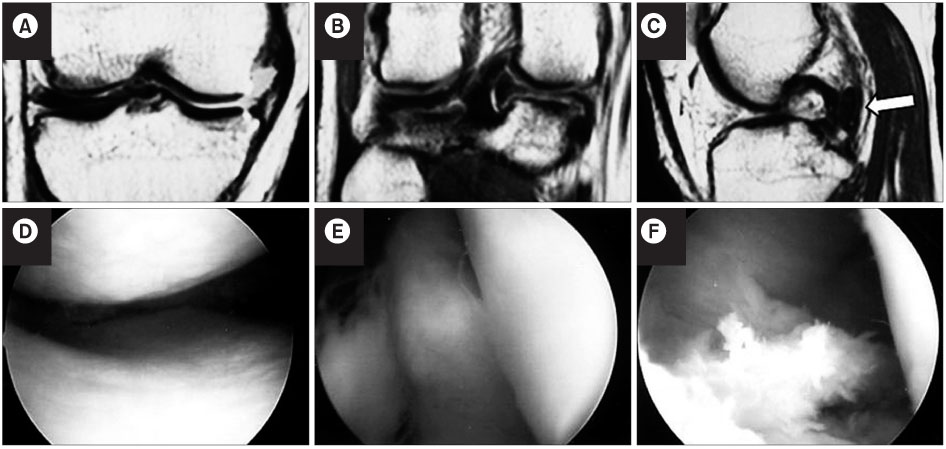J Korean Orthop Assoc.
2007 Feb;42(1):131-135. 10.4055/jkoa.2007.42.1.131.
Posterior Double PCL Sign; A Case Report of Unusual MRI Finding of Bucket-handle Tear of Medial Meniscus: A Case Report
- Affiliations
-
- 1Department of Orthopaedic Surgery, National Police Hospital, Joint Reconstruction Center, Korea.
- 2Seoul National University Bundang Hospital, Department of Orthopaedic Surgery, Korea.
- 3Seoul National University College of Medicine, Seoul, Korea. drchuc@chol.com
- KMID: 2106386
- DOI: http://doi.org/10.4055/jkoa.2007.42.1.131
Abstract
- Among the MRI signs of meniscal bucket handle tears, a double posterior cruciate ligament (PCL) sign manifests on the sagittal images as a low signal band anterior and parallel to the PCL. The mesially displaced fragment may be confined to the intercondylar notch. However, the torn fragment is rarely displaced to the posterosuperior region of the PCL. If it does occur, separation at the anterior horn may be assumed. We propose this type of lesion be called the posterior double PCL sign in contrast to the ordinary double PCL sign. We present a case showing the 'posterior double PCL sign' accompanying an anterior cruciate ligament injury.
Keyword
MeSH Terms
Figure
Reference
-
1. Dandy DJ. The arthroscopic anatomy of symptomatic meniscal lesions. J Bone Joint Surg Br. 1990. 72:628–633.
Article2. Fauno P, Nielsen AB. Arthroscopic partial meniscectomy: a long-term follow-up. Arthroscopy. 1992. 8:345–349.3. Hanks GA, Gause TM, Handal JA, Kalenak A. Meniscus repair in the anterior cruciate deficient knee. Am J Sports Med. 1990. 18:606–611. discussion 612-613.
Article4. Henning CE, Clark JR, Lynch MA, Stallbaumer R, Yearout KM, Vequist SW. Arthroscopic meniscus repair with a posterior incision. Instr Course Lect. 1988. 37:209–221.5. Niitsu M, Ikeda K, Itai Y. Reversed double PCL sign: unusual location of a meniscal fragment of the knee observed by MR imaging. Eur Radiol. 2003. 13:Suppl 1. L181–L184.
Article6. Polly DW Jr, Callaghan JJ, Sikes RA, McCabe JM, McMahon K, Savory CG. The accuracy of selective magnetic resonance imaging compared with the findings of arthroscopy of the knee. J Bone Joint Surg Am. 1988. 70:192–198.
Article7. Reicher MA, Hartzman S, Duckwiler GR, Bassett LW, Anderson LJ, Gold RH. Meniscal injuries: detection using MR imaging. Radiology. 1986. 159:753–757.
Article8. Stone RG, Frewin PR, Gonzales S. Long-term assessment of arthroscopic meniscus repair: a two- to six-year follow-up study. Arthroscopy. 1990. 6:73–78.
Article9. Ververidis AN, Verettas DA, Kazakos KJ, Tilkeridis CE, Chatzipapas CN. Meniscal bucket handle tears: a retrospective study of arthroscopy and the relation to MRI. Knee Surg Sports Traumatol Arthrosc. 2006. 14:343–349.
Article10. Weiss KL, Morehouse HT, Levy IM. Sagittal MR images of the knee: a low-signal band parallel to the posterior cruciate ligament caused by a displaced bucket-handle tear. AJR Am J Roentgenol. 1991. 156:117–119.
Article
- Full Text Links
- Actions
-
Cited
- CITED
-
- Close
- Share
- Similar articles
-
- Ananalysis of the Clinical and MRI Findings of the Bucket: Handle Meniscal Tears of the Knee Joint
- Displaced Double-Layered Lateral Meniscus That Mimicked the Bucket-Handle Tear: a Case Report
- MRI of Bucket-Handle Tears of the Meniscus of the Knee
- Spontaneous Healing of a Displaced Bucket-Handle Tear of the Lateral Meniscus in a Child
- The Displaced Bucket-Handle Tear of the Meniscus: MRi Findings



